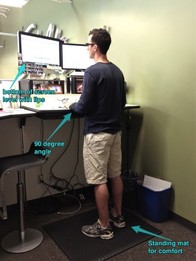
- diabetes
- cardiovascular disease
- metabolic syndrome
- cancer
- erectile dysfunction
- low back pain
- obesity and more
The truly scary thing is that if we sit for long periods of time without breaks most of the current research says that our leisure time activity will not reverse our increased risks. This means if you sit at your desk 8 straight hours at work then go home and exercise the rest of the evening, you still will have an increased chance of having these dangerous problems.
So what can we do?
First off stop sitting for longer than 1 hour in at a time. If you can take a 5 minute WALK break every 30-60 minutes you will mitigate most of the increased risk factors. I have heard many recommend the pomodoro method (25 minutes of work 5 break) for productivity but it may be even better for your health.
The other alternative is to get a sit-to-stand desk. This is the ideal option but it does not come without its own challenges. First, standing does not eliminate the importance of good positioning, you must still stand and work with good posture and still need to take breaks. (Probably will need quite a few for the first week or two) Second, you need to set up your work station so that you have the best chance of sustaining your new standing position comfortably. The best tips are to:
- Get a foot stool. Trust me you will use it
- Get a bar stool to lean on from time to time (This really helps)
- Have a cushioned pad to stand on and wear comfortable shoes
- Start slow. In the first few weeks it is wise to only stand for a max of 2 hours in a row. This gives your body some time to acclimate to your new level of activity
Besides sitting causing issues from a disease and metabolic stand point it also creates many issues from a musculoskeletal view. Sitting causes the shortening of and decreased blood flow to many muscles throughout the body
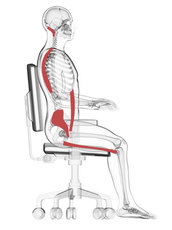
- Neck: Self mobilization with rotation
- Thoracic extension mobilization
- Pectoral myofascial release
- Hip mobilization and lengthening
- Ankle mobilization with movement
That's it. Five moves, all of which will probably take you about 10 minutes once you get them down and give you greater mobility, decreased pain, and increased longevity. i.e. NO EXCUSES DO THEM!
Neck: Self mobilization
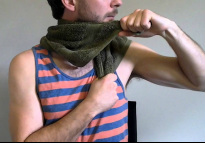
Step 1: drape the towel so that each end hangs over your shoulders.
Step: 2: Take the right hand and grab the left end of the towel. (this hand will not move during the mobilization)
Step 3: Grab the right end of the towel with your left hand so that the towel is firm around the neck and your hand lies right on the jaw line (hand closer to your face and jaw than in the picture)
Step 4. Starting with your head straight forward turn slowly to the left as you apply tension with the towel.
Perform 10-15 per side at the end of the day to keep the muscles and joints in the neck supple and healthy
Thoracic Extension Mobilization
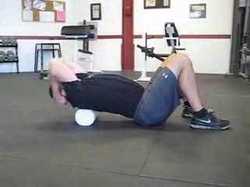
Sit with your upper back against either your foam roll or the arm of your couch.
Clasp the hands together and place them at the base of your neck and bring your elbows together.
From this position you are rocking back over the roll into extension to increase the glide and joint mobility of the thoracic spine. Perform between 20-30 or as many as it takes to make a change.
Pectoral Myofascial Release
The best technique to make a change in the tissue is to find the knots and slowly start making large circles around the restricted tissue, making each circle smaller and smaller until you are in the center of the knot or most painful area.
Remember healthy tissue will not hurt so if you are getting some pain that means that you have some abnormal tightness, scarring, nerve activity, or blood flow in these muscles. Do the technique until you make a change but at minimum 2 minutes on each shoulder.
Iliopsoas (hip) Mobilizaton
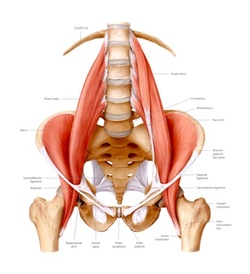
*for the sticklers it is actually 2 seperate muscles the iliacus and the psoas and the psoas is the one that attaches to the spine)
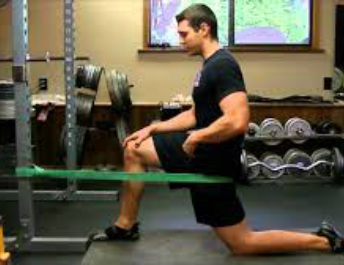
Get on one knee with your other leg out in front like in the picture. (put a pillow down if it bothers the knee cap)
Keep your back straight and shift your entire pelvis forward until you feel a pull across the front of your left hip (if left knee is down like the picture). Hold the position for 1-2 minutes and repeat on the other side. (remember it takes about 30 seconds for your body to stop fighting the mobilization so to make a change we need to get through the initial discomfort)
The major mistake I see with this is people bending forward as the shift the pelvis forward. This shortens the iliopsoas and will make it a less effective mobilization.
Ankle/Calf Mobilization
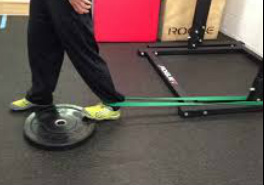
So again this works without the band but is much more effective with it.
- Set the band across the front of the ankle with the stretch pulling from behind.
- Walk out until the tension is significant.
- Place your toes on a book, block, weight anything that raises them off the ground
- Keeping your stretching heel on the ground and leg straight you will step forward with the opposite leg increase the tension on the calf and ankle.
- Hold this for 1-2 minutes and repeat on the other side.
Let us know what you think and if you have any questions.

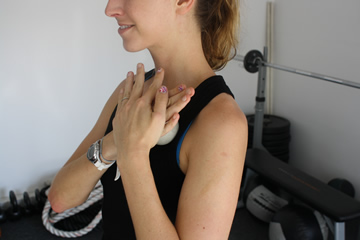
 RSS Feed
RSS Feed